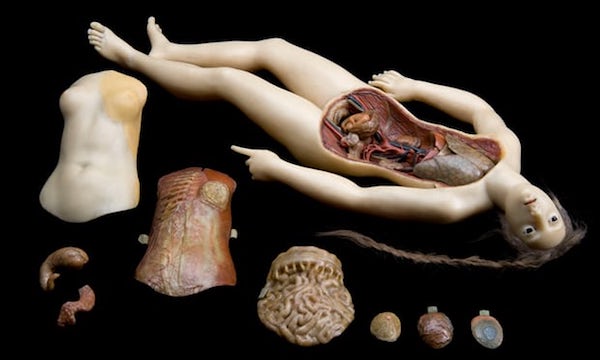Researchers have created a virtual cadaver using 3D scanners to help combat the global shortage. But while synthetic alternatives are useful, they can’t compare to the real thing
[I]n order to solve what could be called a worldwide shortage of dead bodies, researchers at Montpellier university’s medical school in France have created a virtual cadaver using 3D scanners. The process involved dissecting the chosen area of a real cadaver down through eight levels, and taking a 3D scan at each level thereby enabling it to be recreated on a computer screen for a novice student to dissect, virtually.
The use of virtual cadavers in place of the real thing is not a new concept: from the beautiful wax Anatomical Venuses of 18th-century Italy, popularised by Clemente Susini, to the intricate papier-mache anatomical models of Louis Auzoux in 19th-century France, there has long been a need to supplement dissection with less friable analogues made of paper, wax, plastic and soft metals. Even recently we have seen the increase in usage of plastination in medical schools (as well as on public display), virtual dissection tables and the synthetic cadaver – or SynDaver – made from a variety of complex realistic tissues. But the question remains, are these substitutes as effective as the real thing? Not really.

In order to work on humans – alive or dead – one has to become familiar with the huge variety of physical differences. And, of course, a clean, silicon cadaver, minus slippery adipose tissue and blood, is very different from the reality of the human body in all its glory. That said, cadavers donated to medical schools are heavily embalmed and also lack a certain element of realism: they are far paler and solid than flesh and don’t bleed. In addition, one of the reasons many people who would like to donate their body to medical schools don’t have their wish fulfilled is because the acceptance criteria are very stringent.
However, one of the often-overlooked benefits of using real cadavers during study is that they have a power and an agency that fakes and fabrications do not. They teach potential doctors to revere the human body and to treat the dead with dignity, something that plastic or pixels cannot.
Ultimately, these tools are useful to supplement learning, but they will never fully replace the real thing. And a donated cadaver is a precious gift indeed.
Complete Article ↪HERE↩!

